Abstract
This research has been conducted on the situational and special marketing orientation of Hong Kong based fast food companies. Most of the fast food shops in HK are fast causal in nature which tends to serve both Chinese and non-Chinese items demanded by the target consumers. Unlike the global demand of consuming junk foods, HK population also shows such a trend for which many local and international entities are entering into the market for getting a favorable saturation. Although the industry is dominated by some national and multinational chains like- Pizza Hut, McDonald’s, KFC, Cafe De Coral, Wendy’s, the demand, and performance of the smaller chain cannot be ignored easily; this is because of their greater contribution in the total Chinese GDP. Marketing plays a major role for the internal and external activities of the mega industry partners by both attracting and retaining consumers. Such influence can be observed through their segmenting, targeting, and positioning strategies mostly along with a concentration on price. Initially involved by competitive pricing strategy, the industry, especially the domestic partners are getting more innovative like the westerns for delivering higher customer values. At the same time, many companies are using different marketing tools to aware the customers about their potential offerings. Finally, the industry is also subjected where some suggestive actions can be implemented because of several situational defects. Again, those can be overcome through further marketing and operational sophistication.
Problem Statement
Background of the industry
The fast food industry of Hong Kong is also known as QSR (Quick Service Restaurants) that has especially been gradually improving during the last two decades. In 1993, this industry has occupied 13% of total restaurant share, which involves most of the household expenditure estimated for food budget with a wider introduction of both local and global operators.
Today, it is acting as a product- oriented market, which delivers greater and diversified menu choices while domestic entities are mostly private or family owned and global entities are franchising ones. Lan (1995) stated that among a number of food items, chicken fast food, Italian pizza, cutlet, broccoli, baked port chop rice, pastry, desserts are notable delivered by McDonald’s, Windy, Pizza Hut, Café De Coral, KFC, Hardee’s, Maxim’s, Firewood and other fast food companies
Rational for the research
The fast food chain in Hong Kong is becoming highly significant for huge economic contribution and understanding the changes in conventional food pattern of people. As a result, more mega ventures are getting attracted and entering into this industry involving KFC, McDonald’s, and KFC (Ktizo Technologies, 2008).
So, making of a critical evaluation of such industrial development along with related marketing functions would be helpful in realizing a proper reflection of livelihood, standard of living, eating behavior, meal choices of Chinese customers, competitive mode and advantages of major fast food firms, tools and themes of marketing used, basic trend in operating policy and the like.
Research questions and objectives
The basic research question is based upon the fact as what is actual scenario of HK fast food industry and what marketing strategies are being used commonly by the industry? Some other integral research objectives are
- Examination of fast food restaurants on regarding various strategic levels involving business- level, functional- level, corporate- level and global orientation mostly related with 4P factors.
- Analyzing the industrial development to examine the feasibility and possibility of diversified combination including entertainment and retail implication in catering sector.
- Testing of practical application and result of overall strategies
- Testing of the result of price war
- Deliberation of general trend indicating the industry.
Scope and limitations of the study
Since the fast food sector of HK is a potential development criterion from both economic and global marketing perspective, conduction of a study upon those facts would be helpful in enhancing some integral capabilities. Such capabilities involve increasing the analytical power to locate the global and Chinese changes in customer behavior, strategic, corporate, branding, multifunctional, cross- cultural and marketing implications and industrial structure under a structured theme of research. In addition, the overall study has been constrained by some integral factors, as
- Time constraint for making an extensive research task;
- Limited budget;
- Gathering of required primary and secondary information;
- Difficulty in conducting interview because of unwillingness, lack of understanding and misrepresentation by the selected audience.
- Hostile attitude of many people regarding fast food issue;
- Clutter of unnecessary information in secondary source;
- Difficulty in maintaining overall co- ordination and control.
Relevant Literature Review
The selected issue can be further analyzed in terms of associating it with some practical strategic and marketing concepts. Such as-
SWOT analysis
Under this, the strengths, weaknesses, opportunities and threats of the industry can be analyzed, as-
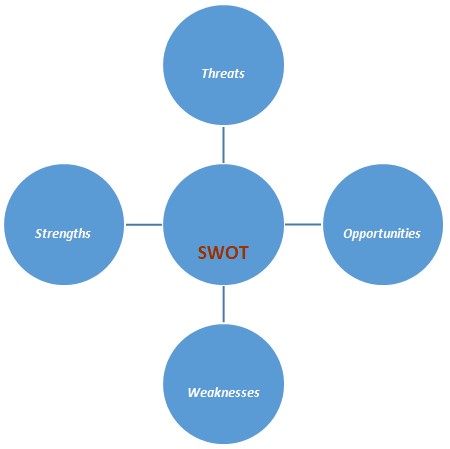
Strengths: Some stronger issues are:
- Superior knowledge and customer base
- Hygienic and standard processing of food by the branded chains
- Concentrated relationship marketing.
- Long- term reputation for increasing industry value.
- Offering of wider number of meal choices, for example- Cafe De Coral offers merely 100 menu items.
Weaknesses: Some vulnerable issues are:
- Persistent superstitions about only negative impact of fast food in some customers mind.
- Limited production capacity suffered by most of the food retailers.
Opportunities: Several scoping factors are:
- Flexible local regulations and control.
- Optimal business model to generate well- tuned product mix.
- Greater interest of foreign mega industry collaborates for enhancing the quality of junk foods.
Threats: Some challenging issues are:
- Greater competitive pressure coming especially from the foreign mega food chain associated with market saturation.
- Inflationary pressure
- Escalation of rent
- Lack of adequate and well- trained labour force.
- Political vulnerability
- Pressure of delivering continuous innovative effort
- Short- term customer attraction on most of the food items
- Increasing cost of processing ingredients.
Competitor analysis
In this case, the use of Porter’s 5 forces model of competition will reveal the actual competitive scenario of this industry (Wetzel, 1999). Such as-
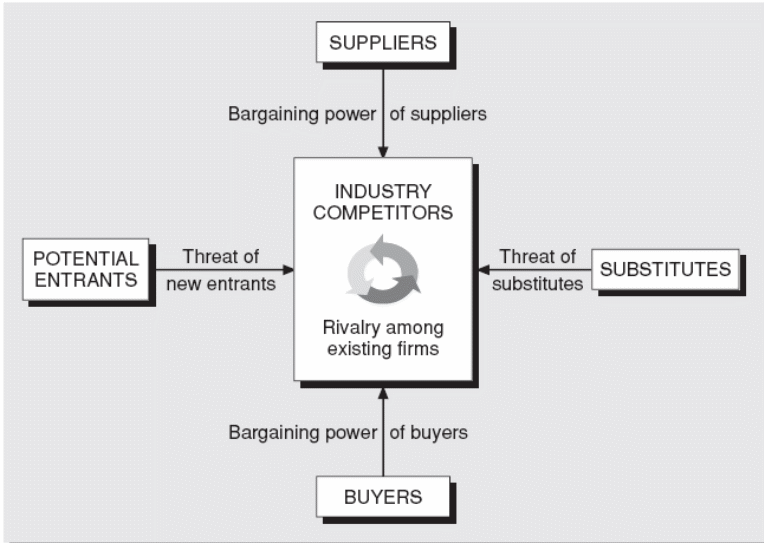
- Threats from new entrants: The basic source of entire challenges affecting the fast food industry is the potential entrance of both national and international new comers. American companies are mostly considered in this issue. Generally, this factor is continuously emphasized by day by day with a huge local demand, favorable trade laws etc.
- Bargaining power of suppliers: Since the supply of various food ingredients like- chicken, potatoes, patties, eggs, vegetables, fishes are not adequate from domestic sources, outsider suppliers are being frequently engaged in the supply process. Those suppliers often pose greater bargaining power than buyers do.
- Bargaining power of buyers: Because of a reasonable level of demand, fast food customers tend not to expose more bargaining power over price. In fact, there exists a moderate level of buyer- seller understanding.
- Threats of substitute products: Butod (2009) stated that there are a lot of substitutes among which the most challenging are home made foods, formal restaurant foods, healthy foods etc.
- Rivalry among existing forms: Such relationship exists among most of the food retailers in Hong Kong. For example, McDonald’s is the nearest competitor of KFC which potential competition can also be seen among Cafe De Coral, Fairwood, Domino’s, Pizza Hut, Hardee’s, Wendy’s etc.
The marketing mix concept
It is the set of controllable and tactical marketing tools those blended by the firm to producing the response it wants in the target market (Kotler and Armstrong, 2006). It is also known as 4P, which incorporates the following ingredients
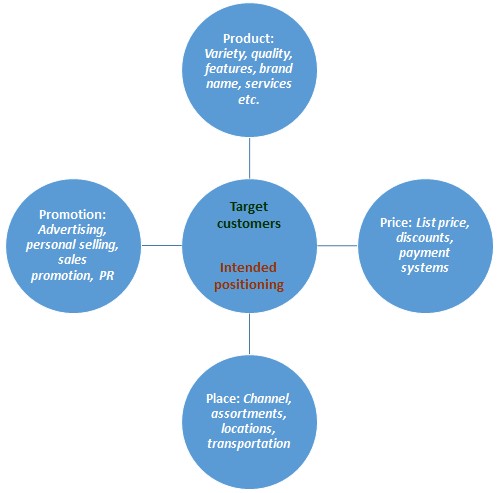
However, these 4Ps can be better applied by 4Cs to generate long- term customer value, as
Table: 4Cs of HK fast food marketing mix. (Source- Kotler and Armstrong, 2006)
Ansoff’s product/ market expansion grid
It refers to a strategic growth theory for starting up or acquiring business outside the fast food industry’s current products and markets. Therefore, the four ingredients of this model can be applied in fast food case, as-

- Market penetration: Here, the food chain sells existing menu items to its present local customers for raising revenue. Generally, this phase does not require any internal modification of served foods for gaining new customers.
- Market development: It involves marketing of present items in a new market. Branded foreign fast food franchisers mainly fall in this criterion.
- Product development: Here, the food retailers like Café De Coral, McDonald’s, KFC etc. tend to engage in innovative tasks for delivering new delicious items to for replacing the present ones
- Diversification: It involves delivering completely new dishes to new customers, for example, introduction of a new healthier chicken nugget for the children (Qingfen, 2008).
The Boston Consulting Group approach
The BCG matrix is a portfolio planning process that can be used to evaluate HK fast food chain regarding relative market growth rate and relative market share. According to this model, the considering industry can be shown at a specific position among the four alternative positions (Griffin, 2006), as below-
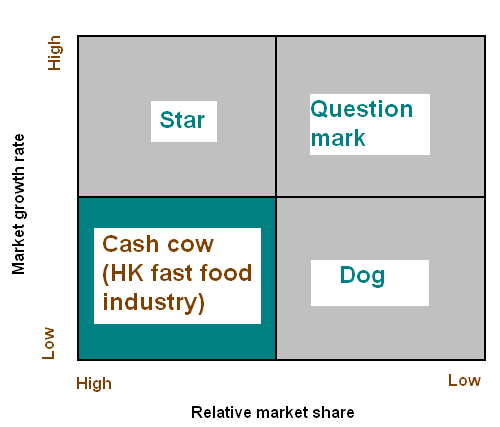
- Star: It is the high- growth, high- share business or product. It often needs heavy investment for financing the rapid growth.
- Question mark: It is the low- share business unit in a high- growth market. It requires a lot of cash for holding its market share, let alone increases it.
- Dog: It is the low- growth, low- share business, and product.
- Cash cow: It is the low- growth, high share business or product. According to situational positioning, HK fast food chain is being placed here for its capability of generating adequate cash that can be used for paying corporate bills and support to the subsidiaries. It also requires insignificant needs of investment for holding current market share as many of the HK foreign food retailers are recognized for obtaining huge cash turnover yearly (Yong, 2009).
STP strategy
It stands for segmentation, targeting and positioning the market (Kotler and Armstrong, 2006), as

- Market segmentation: It refers to divide the market into small groups of buyers in terms of distinct needs, characteristics or behavior requiring different products or marketing mixes. In this case, demographic variables are used for segmenting the local market regarding the age, race, gender, income, occupation, education, region, nationality etc. of fast food consumers (Kotler and Armstrong, 2006).
- Market targeting: Three most important factors are segment size and growth, segment structural attractiveness and company objectives and resources. Thus, from such point of view, most of the HK fast food retailers tend to practice differentiated marketing by targeting several market segments and designing separate offer for each (Kotler and Armstrong, 2006).
- Market positioning: By this strategy, the intended companies try to occupy a distinctive place in target customer’s mind through their menu, servicing and pricing. Those tasks incorporate identification of possible competitive advantages by creating product, service, channel and image differentiation, as- “I am loving it” brand positioning criteria used by McDonald’s. The next phase is choosing the right advantages and finally, the selection process comes that involves value proposition. With it, the competing companies mainly set the full positioning of own brands or the full mix of benefits upon which they are being positioned (Kotler and Armstrong, 2006).
Methodology
The basic purpose of this part is to identify how the selected methodology would adjust with the main purpose of conducting the research question and. Generally, there are two types of research methodologies, named as qualitative and quantitative. Here, the former one has been followed for exploring the explained form of individual perceptions over the issue (Malhotra, 2010).
Development of an approach
Here, as an applicable research approach, descriptive or qualitative research has been used along with inductive reasoning for reviewing the applied research design and techniques for collecting data. Another important consideration is deciding between inductive and deductive research while the 1st one starts with a question and seeks to explain it. The later generally starts with the issue by working backside of the outcomes. Therefore, the inductive approach is more applicable in this case for conducting the entire research.
Primary research
Here, both interview and observation methods have been used as primary research technique. Such interview has been conducted among 25 respondents who are the regular customers of HK fast food. Through such kind of objective discussion, desired information have been collected which are valid and reliable in nature. Therefore, a survey questionnaire containing 20 questions have been prepared containing specific themes of different issues regarding the junk food (Malhotra, 2010). The interview has covered the criteria below-
- Who should be interviewed and for what reason?
- Where and when the interview should be conducted?
- What information is being required by the respondents?
- How to represent the purpose of the interview?
Thus, the information has been collected in such way, which was highly confidential in nature so that the respondents would not hesitate to make the right answers. The basic criteria that have been covered by the questions were current offerings of HK fast food, most favorite items, level of price consciousness, favorite brand, frequency for having the fast food items, problems faced by ant food or restaurant service etc.
Then, the observation has conducted upon 5 well- known restaurants as McDonald’s, KFC, Burger King, Cafe De Coral and Maximus by using the disguised method. Such observation has taken place in a natural environment while the respondents have gone to different food court to enjoy meals (Malhotra, 2010).
Secondary data source
Secondary data can be defined as the processed data, which already exist and can use as potential sources of information. However, several secondary data sources used for this research are global and domestic journals and reports, business directories and magazines, periodic HK fast food industry reports, newspaper articles, books, chamber of commerce and internet articles and columns etc. (Malhotra, 2010).
Reliability and validity test
Reliability can measure the random error absence, which can be erased by standardized surveys with preparatory information. For maintaining internal validity, random sampling technique to select respondents for the purpose of handling outsider misinterpretations while outer validity has been maintained by generalizing the results and findings. Here, extra assistance and knowledge of some marketing theories have been taken (Malhotra, 2010).
Data analysis
For both secondary document and primary interview, the data analysis technique follows the paths for analyzing qualitative information. Therefore, laddering technique has been applied here for discovering means- end hierarchies in order to explore the basic relationship among the projected variables. It incorporates a customized interviewing structure through a line of directed probes to identify the objective of three variables as attributes, values, and consequences.
The 1st variable indicates an environmental description through an inductive approach, 2nd implies an empirical evidence and 3rd depicts the ultimate outcomes. Lastly, those three objects have been categorized to reach the research goal (Malhotra, 2010).
Findings
This part will consider various facts related with the core issue, as-
Historical evaluation of the industry
The HK fast food industry can be characterized by long race of diversity regarding both success and experience. From 1980 to 1997, the industry had gained HK$ 500 million to HK$ 12.9 billion sales when there were about 377 to 1500 fast food shops in Hong Kong (Wetzel, 1999), as-
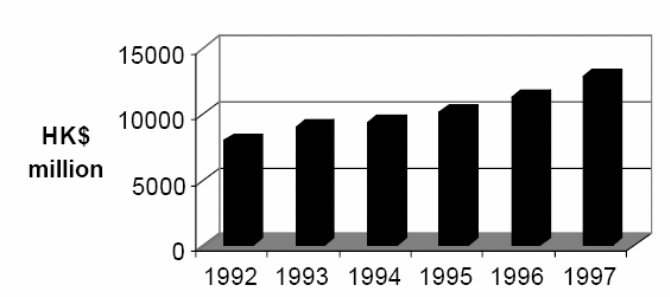
This condition is in more advanced point in the recent period as in 2006, the amount of total receipts from HK restaurant sector was US$ 7.9 billion and buying value was US$ 2.7 billion. It is showing a clear growth of 9.5% and 7.2% than the previous year, as-

Since the industry has been recognized as “Gourmet Paradise”, there were about 10000 restaurants consisting of both Western and Eastern cuisines and culinary delights during the same year (GAIN report, 2007), as-

In this statistics, more than 50% of total restaurants were Chinese as 4684 in number since up to 95% of the local population and 53% of total 25 million visitors to the region were Chinese. Additionally, many outsiders love to take Chinese meal while the average cost can be recorded as HK$100-300 each individual. Because of the liberal entrance policy and huge customer attraction for the branded food retailers, many external, especially, American fast food companies are being popular in Hong Kong increasingly.
Some Japanese food chains, snack and coffee shops are also getting popularity since the range of taking a meal at foreign dining corner is HK$100- 300 each person. However, fast food shops are being considered as one of the most popular dining choices of HK people with approximately 1602 enterprises in 2006.
Different survey results show that HK people are one of the most inquisitive fast food customers of the world who tend to enjoy convenience and lower price of various food items. Since competition is a higher influential factor in this industry, almost all the industry partners face an extra pressure for keeping a lower price. Thus, the average expense can be counted as-
Table: Average price list of HK fast foods. (Source- Shull & Wolf, 2007)
For meeting such competition, several companies are adopting innovative modes for refurnishing their outlets to become modern, attractive, and roomy. At the same time, for satisfying the health- concerned people, many of them already been initiated modified materials and extended healthy- food menus regarding salads, fresh juices, fruits and so one (Shull & Wolf, 2007).
Analysis of industry structure
As mentioned previously, HK fast food sector is consisted of internal and external chains while the later is functioning in the market from 1970. With some initial unsuccessful periods, most of those foreign retailers have been entered into the market with as franchisers. Within this period, foreign food retailers of Hong Kong are especially concentrating over the hamburger, chicken and pizza sectors. So, the contribution of local chains, hamburger and international chains, local independent stores and Italian segment can be shown below denoted by their starting words (Wetzel, 1999), as-
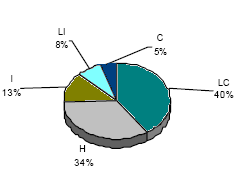
Contingent explanation of those segments are
- The leading fast food franchiser of the world McDonald’s is the prominent producer of hamburger which had been started its HK operation in 1975 with more than 1 million transactions yearly and 144 stores in 1997. Its sales idea is being perceived as perfect in HK context since its more than 6.4 million populations enjoy McDonald’s items available at the busiest street side. Hardee’s poses 22 stores with wider meal options inclusive chicken while Wendy’s and Jack Box pose comparatively low share (Wetzel, 1999), as-
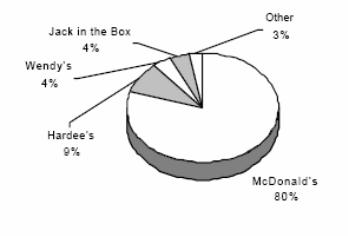
- KFC is in leading position in chicken fast food segment with 75% market share by running over 23 stores. Another US company named as US Hartz and Wendy’s are also expert in preparing chicken food, pudding, ice- cream and cakes (Wetzel, 1999), like-
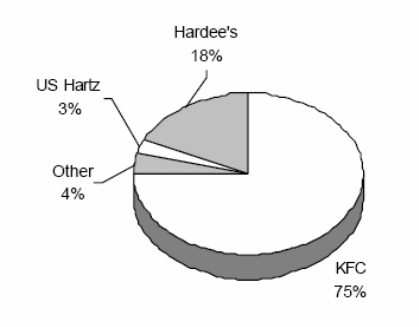
- Pizza Hut had established in 1981 and gained 80% of pizza market share associated with additional sales of sandwiches, pasta and local meals (Wetzel, 1999). Others positions are-
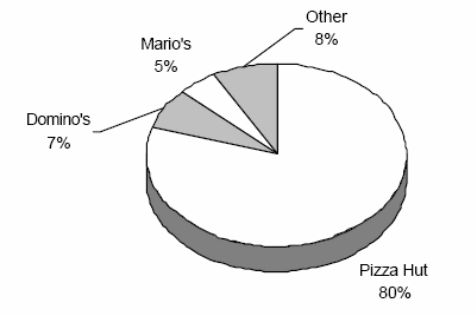
- Among mega local chains, Cafe De Coral is in leading position that had been established in 1968. Today, it serves moreover 300000 customers daily with 540 global and 120 HK chain hops. It earns yearly turnover of HK$2.7 billion and income of HK$258 million from this region in 2004. Fairwood restaurants follow almost similar strategies of Cafe De Coral although its performance has been fallen over past few years (Wetzel, 1999). 1997 scenario can be presented as
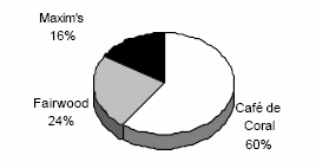
Domestic independent stores
HK occupies various individual fast food and noodle stores for delivering different mix of Chinese and Western dishes at lower prices, which are mostly operated by couples (Wetzel, 1999). Those contribute about 8% of total fast food turnover and categorized by two basic criteria including Chinese and western dishes. The former one involves rice noodle soup, normal soup, fried vegetables, Soya bean, rice/fish/meat, dumplings, congee etc. as hard foods while later involves ham/ egg sandwiches, hamburgers, fried eggs and hams etc.
Local beverage items are soybean milk, Chinese tea and other soft drinks while the western items are milk tea and coffee, beer and the like. Apart from these, there are so many popular and less popular dishes delivered by both sort of food courts which are gradually extending the customers preference level (Wetzel, 1999).
Level of consumption
Since the HK fast food industry is an example of a saturated market (Wetzel, 1999), the pattern of customer consumption over the sector can be depicted as
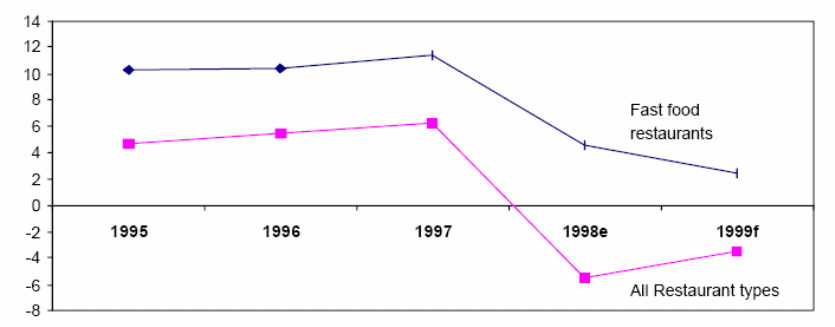
Diversification strategy
Since, it is being well recognized in target customers mind for showing various diversified functions, success generally comes from twin ways regarding cultural diversity and adoption (Janice, 2007). In relation with this theme, the functional diversification practice of Café De Coral is mentionable. This company has initiated two new food chains in HK involving the Western- style Spaghetti house as well as Chinese retro named as Ah Yee Leng Tong.
Although those subsidiaries have been affected by competitive challenges greatly, those gained a higher level of customer acceptance. Introduction of Bravo restaurants had differentiated the company from competitors as “mid- market, consumption- style boutique café restaurants”. Apart from outlets, HK fast food chains tend to arrange diversified product lines regarding new offer development, product localization, new segment orientation (child food), ideal diet and health conscious food, lunch and dinner pummel menus etc. (Wetzel, 1999).
Market competition and positioning
A summary of the core industry competitors and their relative brand positioning can be listed (Wetzel, 1999), as below
Table: Evaluation of competitive positioning. (Source- Wetzel, 1999)
Distribution strategy
The use of domestic and global channels has established standard means for huge production, warehousing, preserving of ingredients and final delivery of orders. In this regard, KFC and McDonald’s are in top position. Thus, centralized procedures are generally practiced here for continuously rotating the intended menus to keep up a greater variety of dishes, especially by the local chains.
Additionally, the industry has been introducing new and seasonal items by utilizing an inner kitchen. Here, the purpose is to prepare side items although basic dishes are also prepared in case of smaller restaurants without adequate space for placing essential cooking appliances (Wetzel, 1999).
Sourcing strategy
As the manufacturing and supply capabilities of domestic suppliers are not adequate for serving foodstuffs and core ingredients to the extended food chains, the industry is not confined within centralized supply chain management concept. It focuses on the industrial dependency over imported items. Other notable considerations in choosing a supplier incorporate the corporate philosophy regarding hygiene and health values and uniformity of items. Basically, three types of sourcing strategies are used here, as-
- In direct import of finished food items, greater quantity of US good enter into HK market ranging from chili sauce to canned chili. However, apart from limited competitive pressure from that supply, industrial success raises from the giant retailers linkages with distribution channels of smaller and individual ones.
- In direct import of unfinished food items, restaurants basically guarantee the uniformity, quality and testing expectations of customers (Marr & Hatfield, 2004). Beef, French fries, chicken patties, fruit juice, fillets, Ore- Ida frozen potato etc. are imported through containers.
- Finally, through local sourcing, a good relationship can be maintained with local community in terms of creating a favourable business image. Beef is the most common item collected through local sources followed by buns and vegetables (Cee & Theiler, 2004).
Strategic orientation at economic recession
The HK fast food industrial cost minimization strategy has been greatly influenced by the current recessionary pressure over the world. For this reason, companies are trying to source their desired food ingredients at comparatively lower prices with some extent of vertical integration.
For example, Café De Coral has gained a HK$13 million Panamanian company named as Scan food International along with 2 subsidiaries (Scanfood Ltd. and Dongguan Continental Foods). As a result, the company now can enjoy personal ham supply by accessing Scanfood’s distribution channels for pork chops and fish fillet (Wetzel, 1999).
Marketing and promotional strategy
While the global chains possess more interest in creating advantages that are more differential over the local ones and at the same time everyone is trying to boost on marketing. During the current phase of economic recession, aggressive marketing would be the most proactive tool used by the industry (Wetzel, 1999). Some mostly usable promotional tools are-
- Television ads: Instead of being expensive, ads are mostly used by many companies shown on Chinese language television.
- In- store promotions: McDonald’s is the most prominent chain in doing such sort of promotion through its campaign. In it, the company uses Disney toys, which are given with per buying of larger food, seldom generate consumer fury. Hardee’s also serves Hardee’s Birthday Party Combos for teams of 5- 10 children. Since sales tend to fall immediately after the completion period of those promotions, it is essential for the promoting groups to reemphasize on such effort through mass advertisement.
- Coupon redemption: Such coupons are used for sales promotion purposes, which are generally delivered through magazines and newspapers.
- Joint promotional scheme: It incorporates supermarkets promotions, shopping malls events etc. for establishing better relationship with one food chain with other. For example, private car companies would tank up at Shell may obtain free coupons from Wendy’s, McDonald’s, and Hardee’s. Similarly, arranging of educational training, sales missions, trade shows, and seminars are incorporating joint promotional efforts offered by local supermarkets, food shops, and Western fast food houses.
Evaluation of target customer groups
Such evaluation also incorporates target market differences and similarities of various local and non- local entities. For example, along with young and adults, McDonald’s especially targets child segment of Hong Kong. For this vision, it tries to make a clear, distinctive, and unique communication model in terms of creating “McDonald’s experience” for which HK children love to enjoy meal from it. Wendy’s basic target customer groups involve young generation as school and college students and family members for whom it offers discounts.
KFC’s target market groups also consist of young generation and young couples. For them, complete meal packages are offered rather than single menu. Pizza Hut is mostly popular for younger and family segments for having a nice weekend meal. Cafe De Coral maintains a careful market segmentation strategy under which it considers size of the population, income level affected by employment ratio, access to natural assets, changing customer tastes and choices, rules and regulations and nature of competition.
Generally, it targets young consumer segment ranging from 18 years to more in age along with potential health concerned people who pose the desire but yet not purchase the junk foods for some inherent restrictions. Eventually, Fairwood also follows the similar strategy of targeting marketing, which is recently refurbishing its brand image for attracting younger group (Wetzel, 1999).
Implementation of fast food marketing mix
The 4 ingredients of fast food are managed by the industry by the following ways
- Many restaurants, especially Cafe De Coral arranges 100 types of food products on a continuous basis for meeting distinct choices of customers. Other restaurants also use standard western cuisine and conventional Chinese manes as their product mix (Feerasta, 2002).
- Cafe De Coral normally charges reasonable prices for almost all of its menus while bundle pricing is more demandable. Here, grouping pricing is also a common practice, like- deli sandwiches, salad, pasta, and sausage and feta cheese as a package. Upon the average cost of $7.75, price can be charged as over $10. Additionally, an appetizer dish is priced as $5.25, wide pork chops as $11.50, banana cream pie as $2.50, meat loaf and fish and chips as $7.95 and hot apple pie as $2.50 etc.
- In placing consideration, most of the HK fast food shops are located in urban areas regarding core business, shopping malls, industrial centers, public and private housing, and real estates (Zuber, 2001).
- Finally, now- a- days, fast food chains are operating proactive advertising programs through which the mega ventures try to favorably enhance their brand image. Such efforts are helpful not only for delivering a high quality but also value foods, which match the conventional living standards of people.
Special force of price competition
The overall analysis of market drivers reveals a fact that there exists an explicit and implicit price competition among the giant industry partners at both national and international level (The China Post, 2009). For example, the well-known battle exists between McDonald’s and KFC, which is recently forcing both companies to enhance their menu items and lowering price to capture more customers.
In this regard, few months ago, some of the KFC restaurants located in China have cut prices of 5 famous set foods by minimum 20%. Other industry partners have immediately followed this strategy. Furthermore, McDonald’s has introduced a “preferential program” through which similar price cutting strategy has been followed up to 28% of some lunchtime dishes.
Conclusion
Key Recommendation
Like any other sector, the considering HK fast food sector is not fully free from problems and restraining facts against which some suggestive actions can be made, such as
- As many semi- finished goods are frozen, more upgraded, and controlled, distribution channels are needed to be introduced. For this, mega and specialized importers are required for ensuring quality management over the frozen food network.
- Since the price of many imported materials would be high because of high tariffs, the rate of such tariff should be lower enough to sustain the industry profitability. At the same time, the industry partner should take an initiative to motivate, leverage, and promote local suppliers to provide adequate level of qualified ingredients. The Chinese government is another prominent party, which could contribute greatly in this issue.
- Increased level of capital and technological investments by overseas mega ventures.
- Most of the chains do not pose enough interest in conducting formal and extensive marketing research project. As a result, the companies should invest more energy and time for such purpose. Different national and international consultants and agents should be persuaded to participate in such project, especially, for new foreign product introduction process. Therefore, firms should make participation with professional agents who can estimate the real market needs.
- Chinadaily (2004) reported that the industry partners should attend US based trade shows and exhibitions for analyzing the industry at each moment. Desired firms would establish a counter for introducing or promoting their offers, normally visit and meet with other core industry contacts.
- The local traders should enhance their information access upon food management practices, like- proper handling of frozen French fries unless final supply to supermarkets and restaurants. It will also assist in cutting the import expenditures and enhancing the durability of usage.
- Aggressive marketing efforts should be delivered in arranging more TV advertisement by using push strategy in terms of product benefits and tastes.
- Along with foreign chains, all sorts of domestic companies should adapt huge innovative approach in terms of cooking, packaging, and serving.
- All the industry players should take an approach to remove the prejudice and miss- conception about fast food. It would be helpful in creating potential market segment and least positive attitude about junk food.
- Along with existing promotional vehicles, both larger and smaller companies should arrange more promotional programs, like- in- pack premiums as one free meal with one purchase, free-gift option, raffle draws, sweepstakes, contest, and so on.
- Laudon, KC, & Traver argued that in this recent era of e- commerce, the managerial tasks of every fast food center need to be automated and internet- oriented. Therefore, according to the personal affordability of a firm, there should be an integration of related intelligence process, product improvement, and loyalty program to build long- term customer attachment.
- The current recession has revealed some special scopes for Asian as well as HK in terms of seeking new supplying groups from these regions. Such strategic sift would be helpful in assessing domestic market potential and cutting extra costs of maintaining global supply chain for the industry players.
Conclusion
After making an overall analysis, it can be concluded that the Hong Kong fast food industry can be featured by some distinguished attributes, which are unique from both managerial and marketing viewpoints. Since the core component of this industry is the rising consumer demand and awareness for having a tasty and easy dining choice, day-by-day, it is becoming over saturation stage. This factor has also enhanced the overall competitive structures, which are yielding some situational constraints and consumer benefits at the same time.
From the consumer perspective, different companies are getting more innovative to deliver diversified food, service, and authentic quality to the target customers. Additionally, they are also expanding consumer choice criteria by offering different items at lower price. Different types of promotional and marketing options are also delivered for getting more public attachment with the food items. However, not all the industrial activities can run smoothly because of some integral problems relating with sourcing, marketing, environmental, and external affairs of the companies.
Along with others, the major problem includes negative customer perception about the quality of fast food regarding health, quality, and economy. These issues can be resolved by taking adequate measures as mentioned in the suggestion part of this research. If those suggestions are maintained properly, it can be expected that the HK fast food sector would make more contribution in Chinese economy regarding desired market growth rate and share accelerated by upward demand orientation.
Bibliography
Butod, M, 4 Posts categorized: Hong Kong Fast Food Industry, 2009. Web.
Cee, J, & Theiler, S, U.S. French Fries Heat Up China’s Fast Food Industry, 2004.
Chinadaily, U.S. fast-food chains expanding in China, 2004.
Feerasta, J, Practicing multiculturalism can provide better guest service, 2002. Web.
Griffin, RW, Management, 8th edn, Houghton Mifflin Company, New York, 2006.
Hitt, MA, Ireland, RD, & Hoskisson, RE, Strategic Management, 4th edn, South-Western Thomson Learning, Singapore, 2001.
Janice, AY, Fast Eating: Culture in Hong Kong, 2007. Web.
Ktizo Technologies, Hong Kong Fast Food, 2008.
Kotler, P, & Armstrong, G, Principles of Marketing, 11th edn, Prentice-Hall of India Private Limited, New Delhi, 2006.
Lan, L, Hong Kong’s Fast-Food Industry, 1995.
Laudon, KC, & Traver, CG, E-commerce- Business, Technology, Society, 4th Edition, Dorling Kindersley Pvt. Ltd., India, 2002.
Malhotra, NK, Marketing Research- An Applied Orientation, 5th edn, Prentice-Hall of India Private Limited, New Delhi, 2009.
Marr, J, & Hatfield, A, Fast-Food Restaurants: Just What Eastern China’s Consumers Ordered, 2004. Web.
Qingfen, D, Fast food chains hungry for expansion, 2008.
Shull, PA, & Wolf, DL, Hong Kong: HRI Food Service Sector Annual, 2007. Web.
Strickland, A J, & Thompson, AA, Strategic Management: Concept and Cases, 11th edn, Irwin McGraw-Hill, 1998.
The China Post, Convenience stores join price war, 2009. Web.
Wetzel, HR, Market Development Reports Hong Kong Fast Food Market Brief, 1999. Web.
Yong, Y, Fast Food Chain Competition, CRIENGLISH, 2009. Web.
Zuber, C, Analysts: Happier meals may be ahead for McD if sales increase, 2001. Web.